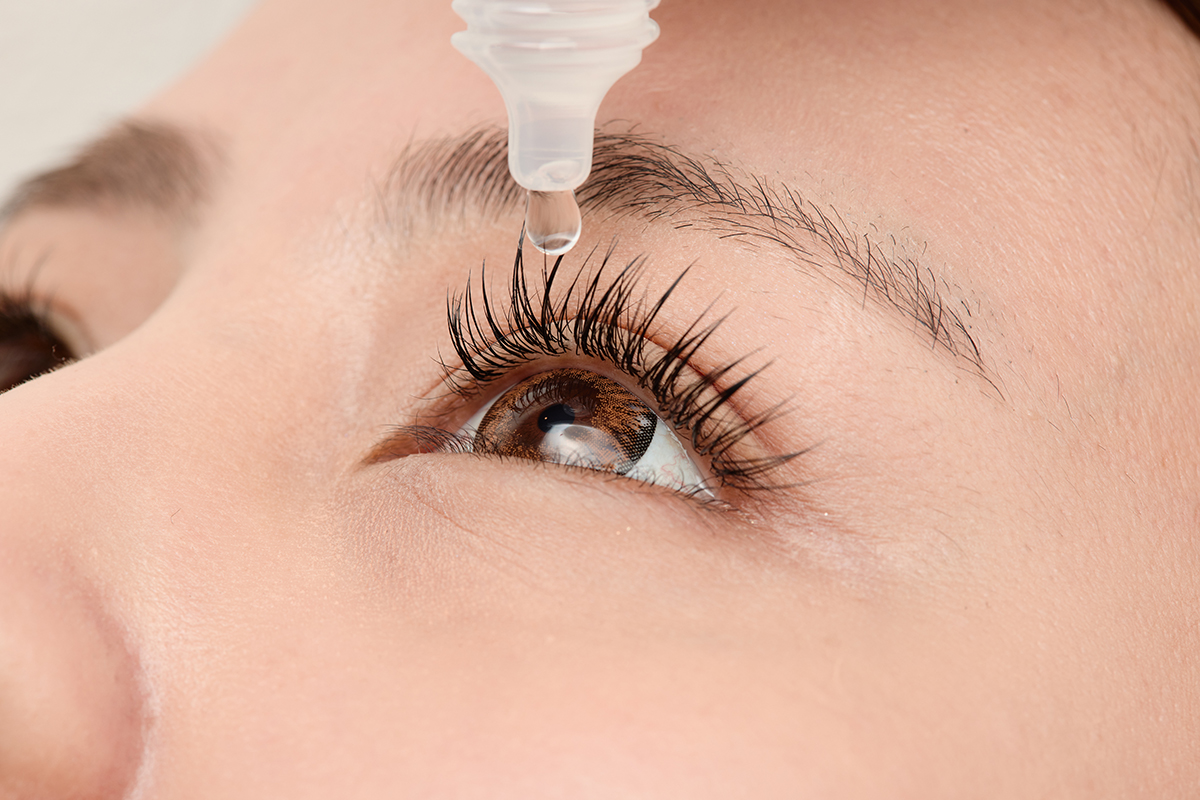
We accept thousands of plans!
Everything you need to know to take care of your eyes — for life.
Burning, stinging eyes? Before you buy a bottle of artificial tears, it’s important to know what’s behind those irritating symptoms. Here’s an A to Z guide to dry eye syndrome.

It’s tough to go through your day with dry eyes. That burning, scratchy sensation can hit at the worst times: when you’re driving, sitting on a video call with a client, or in the middle of a long plane ride. You may notice it more when you wear contact lenses or after a prolonged stint in front of a computer.
Whatever the case, you want the irritation to disappear — fast. Even better, you’d like to know what you can do to make sure it doesn’t reappear.
For either of those things to happen, it helps to know what’s behind dry eyes in the first place. That’s where this guide comes in. Knowledge is power, after all. Use the information here to gain a better understanding of the root causes of dry eye syndrome, how to find lasting relief, and the steps you can take to keep your tear production in balance.
Have questions about your vision or eye health? Book an appointment with your America’s Best optometrist! They're an important part of your care team.
Dry eye syndrome (also known as keratoconjunctivitis sicca) is a common condition, affecting nearly 16 million Americans. It occurs when your tears can’t keep your eyes lubricated the way they should, explains Angelika Pacholek, O.D., an optometrist practicing at America’s Best Contacts & Eyeglasses.
“It could be that you don’t make enough tears to keep your eyes wet, or your tears dry too quickly,” says Dr. Pacholek.
Dry eye may cause symptoms like stinging, burning, redness, watery eyes, and blurred vision. When left untreated, dry eye can lead to eye infections and damage to the surface of your eyes.
Common symptoms of dry eye include:
It may seem odd that having lots of tears in your eyes is a symptom of dry eye. However, your eyes naturally make more tears when they’re irritated, explains Dr. Pacholek. And irritation and dry eye go hand in hand.
Like many eye conditions, dry eye syndrome ranges in severity. The severity of your symptoms depends on the cause, as well as how long you wait to seek treatment.

We accept thousands of plans!
Tear production is at the core of dry eye syndrome. Every time you blink, the front surface of the eye (known as the cornea) gets coated with tears. Your eyes need quality tears to maintain the health of the cornea and provide clear vision.
In addition to lubricating the eyes, tears also wash away foreign matter such as dust. This helps keep the surface of the eyes clear and reduces the risk of an eye infection.
If you have dry eye syndrome, there’s a problem with your tears. Let’s take a closer look:
You don’t make enough tears. Tears are made by glands in and around your eyelids. These glands often slow their production with age — or as a side effect of certain medications (more on that in a moment).
Your tears dry too quickly. The tear film is made of three layers: oil, water, and mucus. Normally, these layers work together to keep the surface of your eyes clear and lubricated. But sometimes, those layers don’t work the way they’re meant to, resulting in dry eye symptoms, Dr. Pacholek explains.
For example, the oil film can sometimes get clogged, especially if you have rosacea or another skin disorder. When the oil film gets clogged, your tears might evaporate too quickly.
Anyone can get dry eye, but certain factors may increase your odds, including:

Your eye doctor can diagnose dry eye with a series of simple tests and help you identify what may be causing your symptoms.
Most people are diagnosed with dry eye after experiencing symptoms and bringing them up with their eye doctor during a regular eye exam. But Dr. Pacholek says it’s not uncommon for eye doctors to pick up on signs of dry eye during an exam even when the patient has not complained of any symptoms.
If you’re experiencing symptoms, it’s important to schedule an eye exam. As you’ll see in a moment, there are treatments available that can help you find relief. Even if you haven’t noticed anything out of the ordinary, ask your eye doctor to check for signs during your regular eye exam.
During your appointment, your eye doctor will ask about your symptoms. From there, they may perform a series of tests to see whether your eyes are making enough tears. If the tests reveal that you have dry eye, your doctor can recommend treatment.
Here are some of the common ways eye doctors check for dry eye:
Slit lamp. This test will reveal if your eyes are making enough tears. First, your doctor will apply eye drops to dilate (widen) your pupils. Then they will look at your eyes through a slit lamp. A slit lamp is a microscope with a bright light that gives your eye doctor an up-close look at the structures in your eye.
Schirmer’s test. This is another check that will tell your doctor if you’re making enough tears. After giving you eye drops to numb your eye, they will put a small piece of paper on the edge of your eyelid. You’ll then close your eyes for five minutes. Once those five minutes are up, your doctor will check the paper for moisture to evaluate the degree of dryness.
Tear break-up time (TBUT). The TBUT assessment measures how quickly your tears evaporate after you blink. To check, your doctor will apply a small drop of dye in your eye and ask you to blink so that the dye coats your eye. You will then look ahead without blinking or moving your eyes. The doctor will time how long the dyed tear film lasts.
You may not be able to resolve your dry eye for good, but there are several treatments that can tame dry eye symptoms and help keep your eyes healthy. The best option for you will usually depend on the cause of your symptoms.
Often, it’s a combination of environmental and lifestyle factors that tend to be the biggest contributors to dry eye. If that’s the case, your treatment options typically include:
Over-the-counter (OTC) eye drops. If you have mild dry eye symptoms, your eye doctor may recommend starting with a type of eye drops called artificial tears. You can buy these without a prescription at any pharmacy — but with so many options out there, it’s smart to ask your eye doctor for a recommendation.
If you’re allergic to preservatives or need to use eye drops more than six times per day, you’ll want to look for preservative-free drops. There are also soothing gels and ointments, eyelid scrubs, and warm compresses you can try for added relief.
If your eyes tend to get red, you may be tempted to buy redness-relieving drops. But Dr. Pacholek cautions that these can actually make redness worse, if applied often. Use them only occasionally, such as before a special event. Don’t use them for more than 72 hours at a stretch.
Lifestyle changes. Many lifestyle or environmental factors can cause or worsen dry eye. Your eye doctor may suggest changes to help ease your symptoms. Changes may include the following:
Tip: The 20-20-20 rule also comes in handy for hobbyists or anyone whose work involves peering at close-up objects for lengthy periods of time.
If a medication you take regularly carries a visual side effect of dry eye, ask your doctor about switching to a different one that treats the same problem. It’s important not to make any changes to your medication routine without consulting your doctor or a pharmacist.
If your dry eye is linked to a medical condition (for example, an autoimmune disorder), lifestyle changes and OTC eye drops may not be enough. Your eye doctor may also recommend next-level treatments if you have severe inflammation and dryness.
The most common doctor-prescribed dry eye treatments include:
Prescription medicines. If OTC artificial tears don’t help enough, your doctor may suggest prescription eye drops. There are also prescription oral antibiotics you can take if your eyelids become inflamed and interrupt tear gland production.
Tear duct plugs. If tears drain too quickly from your tear ducts, your eye doctor may suggest blocking them with tiny gel or silicone plugs (called punctal plugs). Tear duct plugs help your natural tears stay in your eyes longer. These plugs can be removed if needed.
Surgery. Your doctor may suggest surgery to partially or completely close your tear ducts. This is a more permanent solution that prevents tears from leaving your eyes too quickly.
Work with your eye doctor to find the best treatments for you. Then follow your doctor’s instructions as closely as possible. Be sure to follow up if the treatments don’t offer relief or if your symptoms become worse.
If left untreated, dry eye may lead to eye inflammation, damage to the cornea, corneal ulcers, and even vision loss.
Also, because your tears protect the surface of your eye from bacteria, having too few tears may increase your risk of eye infections.
Making a few simple lifestyle tweaks may help keep dry eye symptoms at bay.
In fact, many of the same lifestyle changes that are recommended to treat dry eye symptoms can also help prevent dry eye. These include the following:

Dry eye is a common complaint among people who wear contact lenses.
When you insert a contact lens, the lens actually separates your tear film, which lowers the amount of water in the second (watery) layer of your tears. This can create dryness and friction between your lens and cornea.
That doesn’t mean you can’t wear contact lenses, though, says Dr. Pacholek. You can bolster your natural tears with contact lens–specific eye drops. Carefully following your doctor’s recommendations for wear-and-care also helps.
There are also many new materials for soft contact lenses that help combat dry eye, she adds. Silicone-based hydrogel soft lenses, for example, slow down the rate of water evaporation, which helps cut back dry eye symptoms. Single-use contact lenses are another good option for those with dry eye.
For more severe cases of dry eye, and after the above options have been tried, there are also special contact lenses known as scleral lenses that can benefit people with dry eye. Scleral lenses protect the surface of the eye and “trap” moisture.
Scleral lenses are larger than standard contact lenses. They also sit on top of a layer of tissue over the white part of the eye (sclera), as opposed to the cornea. A fluid barrier prevents the scleral lens from touching the cornea, which can improve eye comfort in people with dry eye syndrome.
Talk to your eye doctor to find contact lenses that are right for you.
Has it been a while since your last eye checkup? Now’s the time to book an appointment!
6 Things Your Dry Eyes Are Trying to Tell You
7 Ways to Ward Off Dry Eyes Without Giving Up Your Contacts
6 Things an Eye Exam Can Do for You (Even if You Have 20/20 Vision)
How Weather Changes Lead to Eye Problems